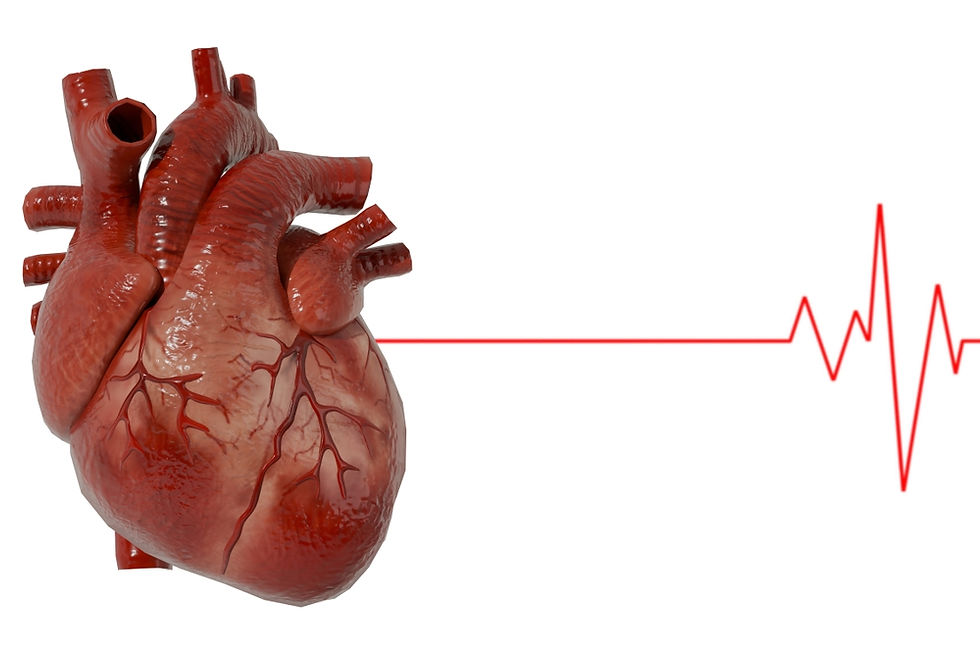Strategies for Entering the Field
- BioSource Faculty
- Apr 2, 2023
- 6 min read
Updated: Mar 2, 2024

You are a licensed healthcare provider or optimal performance coach who wants to add biofeedback to your practice but are overwhelmed by your choices. You want answers to questions like, "What are the different types of biofeedback?" and "Which disorders can I treat with each, or how can I use the various modalities to help clients achieve optimal performance?" We designed this guide to introduce you to the major biofeedback modalities and provide conservative strategies for entering the field.
Click on our narrator icon to listen to this post.
Biofeedback, HRV Biofeedback, and Neurofeedback
There are three popular "doors" for entering the field: Biofeedback, HRV Biofeedback, and Neurofeedback. Biofeedback includes the electrocardiograph (ECG), electrodermograph (EDG), electromyograph (EMG), heart rate variability (HRV), respiration, skin conductance, and temperature. HRV Biofeedback encompasses the electrocardiogram (ECG), electromyograph (EMG), photoplethysmograph (PPG), and respiration. Finally, Neurofeedback delivers EEG training using 1 to over 19 scalp sensors.
A special thanks to Dr. Donald Moss and Judy Crawford for their editorial magic.

Licensed healthcare professionals may provide biofeedback to treat diagnosed disorders. You must have an appropriate healthcare license to treat clients with a diagnosed disorder using biofeedback independently. Alternatively, you may work with such clients under the supervision of an appropriately licensed professional.
Biofeedback may also enhance optimal performance and general stress management, relaxation, and well-being. In most states, such work does not require a healthcare license. Nevertheless, please check your state's practice act for optimal performance coaching and stress management practice requirements.
Before discussing strategies for entering the field, we will review the major biofeedback modalities. Their description is partly adapted from Moss and Shaffer's (2022) A Primer of Biofeedback, which you can purchase from AAPB in its member or non-member stores. The authors have donated their royalties to AAPB.
Electrocardiograph
The electrocardiograph (ECG) uses surface electrodes to detect the R-spike of the electrocardiogram to monitor and train heart rate variability (HRV). "HRV is the organized fluctuation of time intervals between successive heartbeats defined as interbeat intervals" (Shaffer, Meehan, & Zerr, 2020). Providers use HRV biofeedback when treating anxiety, asthma, depression, diabetes, post-concussion syndrome, preeclampsia, and hypertension (Moss & Shaffer, 2022).
Many electrode placements are possible for the electrocardiogram. In biofeedback, the most widely used is the wrist-to-wrist placement because it does not require removing clothing and preserves the modesty of the client.

Electrodermograph
The electrodermograph (EDG) directly measures skin electrical activity (skin conductance and skin potential) and indirectly (skin resistance) using electrodes placed over the digits or the hand and wrist. Providers use electrodermal biofeedback when treating anxiety disorders, hyperhidrosis (excessive sweating), and stress (Moss & Shaffer, 2022).

Electroencephalograph
The electroencephalograph (EEG) uses scalp electrodes to detect electrical potentials from pyramidal neurons located in the upper cortical layers. Providers use neurofeedback when treating addiction, attention deficit hyperactivity disorder (ADHD), learning disability, anxiety disorders (including panic disorder, phobic disorders, generalized anxiety, obsessive-compulsive patterns, and posttraumatic stress disorder), depression, and seizure disorders (Moss & Shaffer, 2022).
EEG electrode placements range from two to three electrode placements on various scalp sites, determined by the training protocol, to the use of a “neurocap,” a fabric scalp with 19 or more electrodes embedded in the fabric for ease of placement.

Electromyograph
The electromyograph (EMG) uses surface electrodes to detect muscle action potentials from underlying skeletal muscles. Providers use EMG biofeedback when treating anxiety and worry, bruxism, chronic pain, essential hypertension, headache (migraine and tension), and temporomandibular joint dysfunction (Moss & Shaffer, 2022).

Photoplethysmograph
The photoplethysmograph (PPG) measures the relative amount of blood flow through tissue using a photoelectric transducer. The PPG can complement a thermistor (temperature sensor) in temperature biofeedback or detect the pulse wave's peak in HRV biofeedback. Providers use temperature biofeedback when treating chronic pain, edema, headache (migraine and tension), essential hypertension, Raynaud’s disease, anxiety, and stress. They use HRV biofeedback when treating anxiety, asthma, depression, diabetes, post-concussion syndrome, preeclampsia, and hypertension (Moss & Shaffer, 2022).

Respirometer
A respirometer is a flexible sensor band placed around the chest, abdomen, or both that monitors respiration rate, depth, inhalation-to-exhalation ratio, inhalation and exhalation slopes, pauses, smoothness, and effort. Providers use respiratory biofeedback in HRV biofeedback paced breathing protocols and with patients diagnosed with anxiety disorders, asthma, chronic pulmonary obstructive disorder (COPD), dysfunctional breathing, essential hypertension, panic, and stress (Moss & Shaffer, 2022).

Temperature
A feedback thermometer detects skin temperature with a thermistor (a temperature-sensitive resistor) that is usually attached to a finger or toe. Providers use temperature biofeedback when treating anxiety, chronic pain, edema, essential hypertension, headache (migraine and tension), Raynaud’s disease, and stress (Moss & Shaffer, 2022).

How to Cautiously Enter the Field
Our dear friend Eric Willmarth observed that "biofeedback is an excellent way to turn a large fortune into a small one." The initial costs of biofeedback instrumentation and training can be intimidating. We recommend several conservative strategies to protect your bottom line.
First, talk to professionals in your specialty area who have successfully integrated biofeedback into their practice. You can find helpful colleagues at the Association for Applied Psychophysiology and Biofeedback (AAPB) and International Society for Neuroregulation & Research annual conferences and state and regional society meetings like those offered by the Biofeedback Society of Florida, Mid-Atlantic Biofeedback Society, and Northeast Regional Biofeedback Society (NRBS).
Second, consider starting with heart rate variability training instead of biofeedback or neurofeedback. Its training and equipment cost is lower than biofeedback or neurofeedback. You can deliver effective HRV biofeedback training with two channels, including a PPG sensor and respirometer. Since some ECG placements require partial clothing removal, we don't recommend an ECG sensor unless you plan to publish your findings in a peer-reviewed journal. BCIA offers an HRV Biofeedback Certificate of Completion and a full HRV Biofeedback certification. Third, read AAPB's Primer of Biofeedback for an overview of the field. The Primer will provide a more detailed description of biofeedback modalities and how professionals use them.
Fourth, don't invest in equipment until you complete a BCIA-accredited didactic course, which will present the science, history, and theory of biofeedback modalities. Where it is feasible for you, consider an in-person "hands-on" workshop or a hybrid course, which includes a combination of face-to-face and online training where possible; however, virtual or online courses can effectively teach the same educational objectives. In-person courses provide live demonstrations and practical skills training and allow networking with classmates and instructors. Many of these courses are offered by companies that also sell equipment. You should not be pressured to purchase that equipment, software, or anything else.
Fifth, when you are ready and you feel confident that you can understand the various systems and ask good questions, you may wish to purchase a scalable system you can expand to add channels and modalities as you grow your practice. For example, if you plan to eventually offer qEEG assessment, purchase an EEG amplifier with at least 19 channels. International, state, and regional conferences provide great opportunities to visit with the vendors, ask them questions and test drive their equipment. You may also ask more seasoned professionals what they think of various pieces of equipment and the customer service that is provided.
Finally, consider purchasing used equipment with a warranty from highly respected vendors like Bio-Medical Instruments. State and regional biofeedback societies and international membership organizations such as AAPB and ISNR may also list members' used equipment. When weighing private offers, ask whether the equipment is covered by a manufacturer's warranty and whether you may return the system if you are dissatisfied with its performance.
Quiz
Take a five-question exam on Quiz Maker to test your mastery.
Glossary
biofeedback: a learning process that teaches an individual to control their physiological activity, (2) the aim of biofeedback training is to improve health and performance, (3) instruments rapidly monitor an individual's performance and display it back to them, (4) the individual uses this feedback to produce physiological changes, (5) changes in thinking, emotions, and behavior often accompany and reinforce physiological changes, and (6) these changes become independent of external feedback from instruments.
electrocardiograph (ECG/EKG): an instrument that measures the heart's electrical activity.
electrodermal activity (EDA): skin electrical activity generated by eccrine sweat glands.
electrodermograph (EDA, GSR, SC, SP): an instrument that measures skin electrical activity generated by eccrine sweat glands.
electroencephalograph (EEG): an instrument that measures brain electrical activity.
electromyograph (EMG/SEMG): an instrument that measures the muscle action potentials that initiate skeletal muscle contraction; called a surface electromyograph (SEMG) when sensors are placed on the skin surface.
feedback thermometer (TEMP): an instrument that measures relative peripheral blood flow and the temperature of the fingers and toes.
neurofeedback: information about EEG activity that is obtained by noninvasive monitoring and used to help individuals achieve self-regulation through a learning process that resembles motor skill learning.
photoplethysmograph (PPG): an instrument that measures relative peripheral blood flow, heart rate, and HRV.
References
Moss, D., & Shaffer, F. (2022). A primer of biofeedback. Association for Applied Psychophysiology and Biofeedback.
Feedback

We value your feedback because we produce these posts for you. Please complete our brief survey to help us improve this service.










コメント